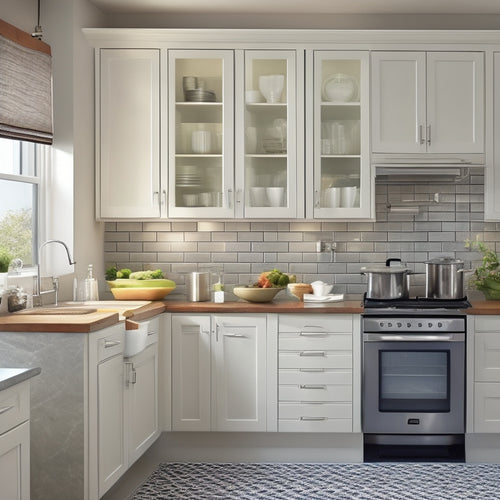
What's Holding You Back From a Clutter-Free Kitchen?
Share
You're likely stuck in a cluttered kitchen cycle because you're neglecting to address one or more of the key areas that are essential to maintaining a clutter-free space. You might be struggling to find a place for kitchen utensils, wasting valuable cabinet space, or letting clutter accumulate on your countertops. Perhaps you're not optimizing your corner spaces, making it hard to access frequently used items, or ineffective in your kitchen workflow patterns. Identify and tackle these areas, and you'll be on your way to a more organized kitchen. Now, take a closer look at each of these areas to open up the organized kitchen you've always wanted.
Key Takeaways
• Inadequate utensil storage leads to clutter, making it difficult to access frequently used items and affecting kitchen functionality.
• Poor cabinet organization results in wasted space, making it challenging to find what you need when you need it.
• Failure to optimize corner spaces and countertops leads to clutter accumulation, hindering workflow efficiency and creating a disorganized kitchen environment.
• Inefficient storage solutions and lack of clear labeling make it difficult to access frequently used items, causing frustration and wasted time.
• Neglecting to utilize vertical space and implement creative storage solutions results in a cluttered kitchen that's hard to maintain.
Lack of Kitchen Utensil Storage
When you're struggling to find a place to put your kitchen utensils, clutter begins to accumulate, and your kitchen's functionality suffers as a result. This common problem is often due to a lack of kitchen utensil storage. Without a designated space for your utensils, they can quickly take over your countertops and drawers, making meal prep and cooking a frustrating experience.
To combat this, consider incorporating vertical hanging storage solutions, such as hooks or a pegboard, to maximize your kitchen's vertical space. This will keep frequently used utensils within easy reach while freeing up valuable counter and drawer space.
Another clever solution is to utilize hidden compartments, like a utensil organizer drawer or a slide-out spice rack, to keep clutter at bay. By thoughtfully designing your kitchen's storage layout, you can create a more efficient and organized space that makes cooking and entertaining a breeze.
Inadequate Cabinet Organization Systems
Now it's time to tackle your cabinet organization. You're probably wasting valuable space with a one-size-fits-all approach, but you can optimize your cabinets by identifying your specific storage needs.
Optimize Cabinet Space
You're likely wasting valuable space in your kitchen cabinets due to inadequate organization systems, which can lead to clutter and disorganization. This is especially true for your pantry, where food and cooking supplies can quickly pile up. To optimize this space, consider implementing a pantry organization system that includes baskets, bins, and shelves to keep items off the floor and easily accessible.
Under sink storage is another area where clutter can accumulate. Installing a slide-out drawer or a pedestal organizer can help keep cleaning supplies and other essentials within easy reach.
Don't forget about your spice rack – a wall-mounted or in-cabinet spice rack can keep your countertops clear and your spices organized.
Customize Storage Solutions
Tailor your cabinet organization system to your specific needs by identifying the items you use most frequently and designing storage solutions around them. This means creating a customized system that caters to your cooking habits and preferences.
For instance, if you have a large collection of spices, consider installing a spice rack under your cabinet or on a floating shelf to keep them within easy reach.
In terms of pantry organization, think about the types of food items you store and how you access them. Do you prefer baskets, bins, or shelves? Design your pantry to accommodate your needs, and don't be afraid to get creative.
You can also utilize the space above your cabinets by installing floating shelves to store infrequently used items, such as special occasion dishes or cookbooks.
Countertop Clutter Accumulation Points
As you take stock of your kitchen countertops, you'll likely notice that clutter tends to accumulate in specific areas. These hotspots, like your coffee station and appliance corner, can quickly become overwhelmed with items that don't belong.
Coffee Station Chaos
Your coffee station, once a haven for your morning routine, has devolved into a cluttered countertop nightmare, with coffee makers, grinders, and accessories competing for space. The coffee pod chaos is overwhelming, with pods scattered all over the counter, and the mug mess is adding to the disarray.
It's time to reclaim your cluttered coffee corner and turn it into a serene brew station. Start by designating a specific area for your coffee maker and grinder. Assign a spot for your coffee pods, and consider using a pod holder or a small basket to keep them organized. Next, corral your mugs and store them in a nearby cabinet or on a mug tree.
Don't forget to wipe down the countertops and clean up any spills or stains.
Appliance Corner Congestion
Identify the countertop areas where appliances tend to cluster, such as around toasters, blenders, and stand mixers, and assess how these zones contribute to the overall cluttered look of your kitchen. These areas often become corner clutter hotspots, making your kitchen feel cramped and disorganized.
To tackle this, focus on appliance organization and corner solutions. Consider the appliances you use daily and those that can be stored away. Designate a specific zone for each appliance, ensuring they're easily accessible yet out of the way. For instance, you can install a slide-out appliance garage or a pull-down spice rack to maximize corner space. This will help maintain a clutter-free countertop and create a sense of openness in your kitchen.
Optimize your appliance storage by utilizing vertical space, such as installing a pegboard or a wall-mounted utensil holder. This will keep frequently used items within reach while keeping countertops clear. By implementing these strategies, you'll be able to create a more streamlined and organized kitchen that's both functional and visually appealing.
Inefficient Use of Corner Spaces
You're probably wasting valuable space in your kitchen by neglecting to optimize the often-troublesome corners. These areas can be notoriously difficult to utilize effectively, leading to wasted space and clutter accumulation. However, with the right strategies, you can turn these corners into valuable storage hubs.
Here are some common mistakes to avoid when it comes to corner spaces:
-
Not utilizing corner shelving to store infrequently used items, such as special occasion dishes or cookbooks
-
Failing to install a carousel or lazy Susan in a corner cabinet to make the most of the available storage space
-
Neglecting to add a corner basket or container to corral small items, like spices or oils
- Not considering a diagonal corner cabinet design to maximize storage capacity
Difficulty Accessing Frequently Used Items
Optimizing corner spaces is just the beginning - now it's time to tackle the daily frustration of struggling to access the items you use most. You're not alone in this struggle; many of us have experienced the annoyance of digging through cluttered cabinets or drawers to find what we need. The solution lies in creating an organized system that allows you to easily access your frequently used items.
Here are some effective solutions to explore:
| Solution | Description |
|---|---|
| Drawer Dividers | Separate items into categories, making it easy to find what you need |
| Cabinet Labels | Clearly label cabinets so you know what's inside without having to open them |
| Rotating Shelves | Install shelves that rotate, allowing you to easily access items in the back |
| Hanging Hooks | Hang frequently used items like pots, pans, or utensils, freeing up cabinet space |
| Tiered Storage | Use stacked storage containers to maximize vertical space and keep items visible |
Insufficient Drawer Organization Methods
With cluttered drawers hindering your workflow, devising a strategy that transforms these chaotic spaces into efficient hubs for your kitchen essentials is vital. You're not alone in this struggle; many homeowners grapple with disorganized drawers that slow them down and add to kitchen stress. To overcome this, it's necessary to implement effective drawer organization methods.
Here are some key elements to keep in mind:
-
Drawer dividers: Separate utensils, cookware, and storage containers into distinct categories to prevent a jumbled mess.
-
Vertical organizers: Maximize your drawer's vertical space by using stackable inserts or trays to store items like plates, bowls, or cups.
-
Install adjustable dividers to accommodate items of varying sizes and shapes.
- Utilize drawer inserts with built-in utensil holders to keep frequently used items, like knives or spatulas, within easy reach.
Limited Wall Mounted Storage Options
Failing to capitalize on your kitchen's vertical space can lead to a cluttered and chaotic environment, making it essential to explore alternative wall mounted storage options.
When you're limited by traditional shelving and cabinetry, it's time to think outside the box. Look for creative solutions that maximize your kitchen's vertical space, such as installing a pegboard or a magnetic spice strip. These space-saving ideas will help keep your countertops clear and your kitchen organized.
Consider versatile options like foldable shelves or retractable hooks that can be easily installed and adjusted to fit your needs. Functional designs like wall-mounted utensil holders or pot racks can also help keep your kitchen organized and clutter-free.
Ineffective Kitchen Workflow Patterns
Inefficient kitchen workflow patterns can suffocate your cooking space, causing frustration and wasted time as you navigate through a maze of cluttered countertops and disorganized appliances. You're not alone if you find yourself constantly searching for misplaced utensils or struggling to prepare meals amidst the chaos.
Some common culprits behind your kitchen's inefficiency include:
- An inefficient dishwashing routine that leaves piles of dirty dishes lingering
- A disorganized pantry layout that makes it difficult to find what you need
- A cluttered food prep area that hinders your ability to focus
- A messy refrigerator arrangement that leads to expired or spoiled food
These patterns can be broken, and it starts with identifying the areas of your kitchen that need the most attention. By streamlining your workflow, you'll be able to cook, clean, and prep with ease, freeing up time for more important things.
Take the first step towards a clutter-free kitchen by examining your daily habits and identifying opportunities to optimize your workflow. With a few simple changes, you can transform your kitchen into a haven of productivity and efficiency.
Related Posts
-

Community Engagement: Learning Through Professions
Community engagement is a powerful tool for fostering a deeper understanding of various professions among children. B...
-

Boost Kitchen Cabinet Storage With Lid Racks
You're looking to boost your kitchen cabinet storage with lid racks. By incorporating lid racks, you'll free up valua...

